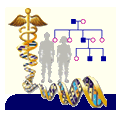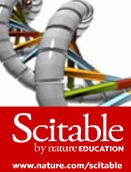Imagen tomada de http://www.mun.ca/biology/scarr/Drosophila_eye_colors.jpg
Información proveniente de http://www.indiana.edu/~oso/lessons/WhiteAlleles.htm
Alelos en el locus white
Puede haber muchos alelos diferentes de un solo gen. De hecho, el número
real es infinito, cualquier par de bases particular se puede cambiar por otro,
y cualquier secuencia de ADN nueva puede insertarse o eliminarse de un gen. Algunos
alelos pueden producir productos sin función, otros pueden originar productos con
función parcial.
Aunque los alelos mutantes pueden ser recesivos respecto al alelo
silvestre, puede existir un orden de dominancia respecto a otros alelos. Por lo
general, los alelos que inactivan completamente un gen son recesivos en todas
las combinaciones heterocigotas, y los alelos con sólo una ligera pérdida de la
función son dominantes a los alelos que tienen una pérdida de función más grave.
Para ver lo complicado que todo esto puede llegar a ser, aquí hay una lista
parcial de los alelos mutantes en el locus white de Drosophila melanogaster, tomado de "Genetic Variations of
Drosophila melanogaster" by D. L. Lindsley and E. H. Grell, Carnegie
Institution of Washington Publication No. 627, 1968.
En 1968, había 154 alelos diferentes que figuran en el libro; hay probablemente miles que se han encontrado, pero todavía no se registran en el libro.
En 1968, había 154 alelos diferentes que figuran en el libro; hay probablemente miles que se han encontrado, pero todavía no se registran en el libro.
w: white
origin: spontaneous
discoverer: Morgan
references: Morgan, Science 32: 120 (1910)
phenotype: eyes pure white
|
wbf: white-buff
origin: spontaneous
discoverer: Safir
references: Genetics 1: 584 (1916)
phenotype: eyes light buff, lighter than we male.
wbf male eyes somewhat lighter than female.
|
w+A: American wild-type
allele of white
discoverer: Timoféef-Ressovsky
references: Timoféef-Ressovsky, Biol. Zentr. 52:
468 (1932)
phenotype: eyes pinkish at eclosion, darken to maroon,
but never become a normal red.
|
wbl: white-blood
origin: spontaneous
discoverer: Hyde
references: Genetics 1: 535 (1916)
phenotype: eyes yellowish ruby at hatching, darkening to
sepialike with age; female
lighter than male.
|
w+O: Oregon-R wild-type
allele of white
origin: in Oregon-R wild type strain
discoverer: Green
references: Green, Proc. Natl. Acad. Sci. U. S. 45:
549 (1959)
phenotype: amount of pigment in diploid w+O/w
less than w+C/ w but difference is not readily detected visually.
|
wBwx: white-Brownex
origin: spontaneous
discoverer: Mossige
references: Dros.
Info. Serv. 27: 59 (1953)
phenotype: eye color
like bw ; no sexual dimorphism
|
w+C: Canton-S
wild-type allele of white
origin: In Canton-S wild type strain
discoverer: Green
references: Green, Proc. Natl. Acad. Sci. U. S. 45: 549
(1959)
phenotype: (see description of w+O)
|
wcf: white-coffee
origin: Xray induced
discoverer: Nicoletti
references: Nicoletti, Dros. Info. Serv. 34: 52 (1960)
phenotype: eyes deep ruby at hatching, but darken greatly
with age.
|
wa: white-apricot
origin: spontaneous
discoverer: Huestis, 1923
references: Morgan, Bridges, and Sturtevant, Bibliog.
Genet. 2: 218 (1925)
phenotype: eyes of male yellowish with orange tone; female
eyes yellower, somewhat lighter than male.
|
wch: white-cherry
origin: spontaneous
discoverer: Safir
references: Biol. Bull. 25: 45 (1913)
phenotype: eyes translucent pink, only slightly yellowish.
|
wa2
origin: spontaneous
discoverer: Bridges, 1929
references: Dros. Info. Serv. 9: 114 (1938)
phenotype: eye color orange, slightly darker than wa. Eyes
of male darker than female.
|
we: white-eosin
origin: spontaneous derivative of w
discoverer: Morgan
references: Morgan and Bridges, Carnegie Inst. Wash. Publ. No. 237: 28
(1916)
phenotype: eyes of female yellowish pink, male and we/
w lighter.
|
wa3
origin: spontaneous
discoverer: Curry
references: Dros. Info. Serv. 9: 114 (1938)
phenotype: eyes brownish orange; slightly darker than
either wa or wa2. Very little sex difference
|
wm4: white-mottled
4
origin: Xray induced
discoverer: Muller, 1929
references: J. Genet. 22: 299 (1930)
phenotype: eyes variegated
|





%204.44.08%E2%80%AFp.m..png)

%206.38.02%E2%80%AFp.m..png)



.png)

0 comentarios:
Publicar un comentario